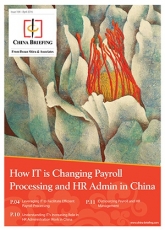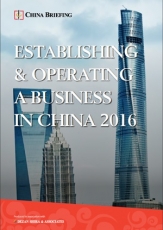China’s Labor Market: Gaining Insights into HR Trends
By Weining Hu
China’s labor market experienced several changes in 2016. Despite job demand cooling in the beginning of the year, China’s job market has been growing steadily since the second quarter. Average monthly salaries have also increased, particularly in first-tier cities. Understanding these developments not only helps existing investors keep up-to-date on HR trends, but can also inform long-term business decisions and minimize risk.
Labor demand shifting to new and emerging industries
With more and more white-collar workers searching for jobs online, data from leading Chinese recruitment websites, such as Zhaopin.com, offer an insight into the labor market. In the first quarter of 2016, total online job opportunities on Zhaopin.com increased by four percent year-over-year, but climbed up to 21 percent in the second quarter, and continued to perk up to 35 percent in the third quarter. The data indicates that more industries and enterprises have restored growth momentum and subsequently picked up their recruitment demand.
Taking a closer look at labor demand, growth in recruitment was mostly driven by new and emerging industries. Internet and e-commerce, insurance, and financial investment were the top-ranking sectors for recruitment demand for the first three quarters of 2016. Additionally, since the second quarter, labor demand in the traffic and transportation sector rose sharply. According to industry analysts, the growth was driven by expanding e-commerce penetration and new government policies allowing public-private partnership investments in transportation and infrastructure projects.
On the other hand, traditional manufacturing industries suffered from over-capacity and cut down job demand. Minerals and mining; inspection, testing and authentication; printing and packaging; property management; office supplies and equipment; and electricity, power and water conservancy were listed among the worst-performing sectors in the first three quarters. With structural reform accelerating, the labor market for traditional manufacturing industries will continue to contract, polarizing manufacturing from new and emerging industries.
Increased competition for white-collar workers
In 2016, internet and e-commerce; computer software; real estate and construction; building materials engineering; and financial investment received the most job applications. Despite this, new and emerging industries like these reported difficulty in finding applicants with the necessary skills. In fact, China’s labor market is now confronted with a shortage of highly skilled talents. Skills Shortages in the Chinese Labor Market, a joint study commissioned by J.P Morgan, Fudan University and Tsinghua University, found that skilled workers account for only about 19 percent of China’s entire workforce, whereas highly skilled workers make up a mere five percent.
![]() RELATED: Payroll and Human Resource Services
RELATED: Payroll and Human Resource Services
With limited skilled workers and a skills gap in the workforce, competition among white-collar workers is high. Other factors, such as declining job demand and increased labor supply, are also driving up competition. In the fourth quarter of 2016, each job vacancy had an average of 41 applicants. Beijing was, by far, the most competitive city for white-collar workers, with almost 94 applicants per vacancy, while Shanghai had an average of 45 per vacancy.
Average salaries rising across cities
Labor costs in China continue to rise, with changes taking places not only in the conventionally perceived traditional manufacturing industries, but high skill sectors. Based on data for 34 key cities compiled by Zhaopin.com, the average monthly salary rose to RMB 7,606 by the end of 2016. Beijing had the highest average monthly salary at RMB 9,835. Shanghai had the second-highest average monthly salary at RMB 9,720, and Shenzhen and Guangzhou followed with RMB 8,640 and RMB 7,853, respectively. High skilled occupations, such as senior management, IT management and project coordination, financial investment services, software and internet development, and legal compliance, offered the highest monthly salaries.
Key takeaways
As China’s economic restructuring continues, labor intensive manufacturing industries are under economic pressure to decrease hiring, whereas new and emerging industries have greater job demand than ever before. Although there are more highly educated university and vocational graduates joining the labor force, the quality of the workforce still does not meet the requirements of these jobs. Consequently, the skill mismatch in China’s labor force is likely to dampen the growth of these industries.
|
Asia Briefing Ltd. is a subsidiary of Dezan Shira & Associates. Dezan Shira is a specialist foreign direct investment practice, providing corporate establishment, business advisory, tax advisory and compliance, accounting, payroll, due diligence and financial review services to multinationals investing in China, Hong Kong, India, Vietnam, Singapore and the rest of ASEAN. For further information, please email china@dezshira.com or visit www.dezshira.com. Stay up to date with the latest business and investment trends in Asia by subscribing to our complimentary update service featuring news, commentary and regulatory insight.
|

 Human Resources and Payroll in China 2016-2017
Human Resources and Payroll in China 2016-2017
A firm understanding of China’s laws and regulations related to human resources and payroll management is absolutely necessary for foreign businesses in China. This edition of HR and Payroll, updated for 2016/17, navigates China’s laws and regulations related to HR and payroll management – essential information for foreign investors looking to establish or already running a foreign-invested entity in China.
 How IT is Changing Payroll Processing and HR Admin in China
How IT is Changing Payroll Processing and HR Admin in China
In this edition of China Briefing magazine, we examine how foreign multinationals can take better advantage of IT in the gathering, storing, and analyzing of HR information in China. We look at how IT can help foreign companies navigate China’s nuanced payroll processing regulations, explain how software platforms are becoming essential for HR, and finally answer questions on the efficacy of outsourcing payroll and HR in China.
 Establishing & Operating a Business in China 2016
Establishing & Operating a Business in China 2016
Establishing & Operating a Business in China 2016, produced in collaboration with the experts at Dezan Shira & Associates, explores the establishment procedures and related considerations of the Representative Office (RO), and two types of Limited Liability Companies: the Wholly Foreign-owned Enterprise (WFOE) and the Sino-foreign Joint Venture (JV). The guide also includes issues specific to Hong Kong and Singapore holding companies, and details how foreign investors can close a foreign-invested enterprise smoothly in China.
- Previous Article Study Buddies: Investing in Sino-Foreign Higher Education in China
- Next Article An Introduction to Doing Business in China 2017 – New Publication from Dezan Shira & Associates









